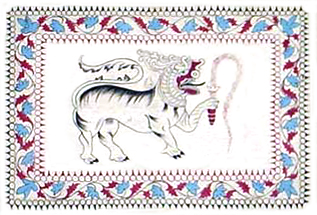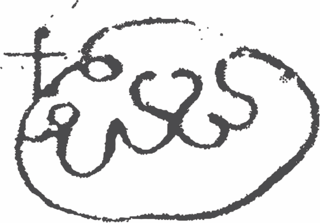
Dominicus Corea also known as Domingos Corea and Edirille Rala, was the son of Don Jeronimo Corea and Anna Corea. Don Jeronimo Corea was also known as Mudaliyar Vikramasinha, Commander-in-Chief of King Mayadunne's army. Jeronimo Corea was assassinated by King Mayadunne's son, Rajasinghe. Dominicus Corea was born in Colombo in 1565. At that time, the Portuguese had colonised Ceylon, and his parents converted to Catholicism.

The Kingdom of Kandy was an independent monarchy of the island of Sri Lanka, located in the central and eastern portion of the island. It was founded in the late 15th century and endured until the early 19th century.

Rajasinghe I was a king of the Kingdom of Sitawaka. He is known for his extreme bravery and patriotism. Born as Tikiri Bandara to King Mayadunne of the Kingdom of Sitawaka, the name "Rajasinha" was given to him after a fierce battle against Portuguese forces. Rajasinha means the King of Lions.

Puviraja Pandaram ruled the Jaffna kingdom during a period of chaos during and after the death of his father Cankili I in 1565. He became king in 1561 following a local uprising against Cankili I. Although he was the nominal king, Cankili I wielded real power behind the throne until his death in 1565. After Cankili's death, Puviraja Pandaram lost power to one Kasi Nainar and Periyapillai. After the death or abdication of Periyapillai in 1582, Puviraja Pandarm was nominated as the king for the second time.

Vimaladharmasūriya I was a king of Kandy from 1590 to 1604. His reputation was built when he successfully repulsed two major Portuguese offensives on Kandy, the Campaign of Danture in 1594 and the Battle of Balana in 1602, in both of which the Portuguese were humiliatingly defeated.

The Kingdom of Sitawaka was a kingdom located in south-central Sri Lanka. It emerged from the division of the Kingdom of Kotte following the Spoiling of Vijayabahu in 1521, and over the course of the next seventy years came to dominate much of the island. Sitawaka also offered fierce resistance to the Portuguese, who had arrived on the island in 1505. Despite its military successes, Sitawaka remained unstable, having to contend with repeated uprisings in its restive Kandyan territories, as well as a wide-ranging and often devastating conflict with the Portuguese. Sitawaka disintegrated soon after the death of its last king Rajasimha I in 1593.

Mayadunne (1501–1581) was a king of the Kingdom of Sitawaka, who ruled for 60 years between 1521 and 1581. Mayadunne was a fierce opponent of the Portuguese, who had arrived on the Island in 1505. He devoted his whole life attempting to oust his brother Bhuvanekabahu, the king of Kotte and thereby preserve the independence of Lanka, which was being undermined by the Portuguese intrigue. He constantly invaded the territory of Bhuvanekabahu of Kotte.
The Wijayaba Kollaya took place in the Kingdom of Kotte on the island of Ceylon in 1521. The three sons of King Vijayabahu VI mutinied against their father, killing him, and divided the Kingdom among themselves. The three sons were products of the king's first marriage and were named Bhuvanekabahu, Pararajasingha and Mayadunne. Queen Kiravella, whom the king married second, had a son named Deva Rajasinghe by her previous marriage. The princes discovered that the king intended to make Devaraja the heir to the throne, at the request of his second queen, and became hostile to the king, and hired a foreigner to murder the king was murdered in the palace.

The Kingdom of Kotte, centered on Sri Jayawardenepura Kotte, was a kingdom that flourished in Sri Lanka during the 15th century.

Dharmapala or Dom João Dharmapala Peria Bandara was last king of the Kingdom of Kotte, in present-day Sri Lanka, from 1551 until May 27, 1597. He is also known as Dom João Dharmapala, the first Christian king in Sri Lankan history.
Sēnasammata Vikramabāhu was King of Kandy from 1469 to 1511. Before becoming independent the provinces that made up the Kingdom of Kandy belonged to the Kingdom of Kotte. Vikramabāhu founded the city of Kandy, and during the reign of Parakramabahu VI Kandy became a separate entity seceding from Kotte. He was from the House of Siri Sanga Bo and reigned for 4 decades, setting an example of longevity and stability for the new kingdom. His son Jayavira Bandara was his successor.
Jayavīra Banḍāra was King of Kandy from 1511 to 1552. He succeeded his father Senasammata Vikramabahu as king and was succeeded by his son Karalliyadde Bandara. During the reign of Banḍāra Catholic friars appeared at court and some conversions took place in the kingdom.

Kusumāsana Devi, also known as Dona Catherina, was ruling Queen of Kandy in 1581.
Bhuvanaikabahu VII was King of Kotte in the sixteenth century, who ruled from 1521 to 1551. He was the eldest son of Vijayabahu VII of Kotte, whom he succeeded, and his chief queen Anula Kahatuda. He was born in 1468 and his brothers were Mayadunne of Sitawaka and Rayigam Bandara. After his father married a second time, his new queen brought a son from another relationship called Deva Rajasinghe, who the king intended to pass on the crown to, and Bhuvanaikabahu and his two brothers responded by fleeing the kingdom, and on their return they had an army given by the King of Kandy.
Vijayabahu VII was the son of Vira Parakrama Bahu VIII, who was an adopted child of Parakrama Bahu VI who founded Kotte. He was born in c. 1445 and grew up with his brothers Sri Rajasinghe, Dharma Parakramabahu IX, and Raigam Bandara. He also had a sister who was married to Manamperi Arachchi.
The Danture campaign comprised a series of encounters between the Portuguese and the Kingdom of Kandy in 1594, part of the Sinhalese–Portuguese War. It is considered a turning point in the indigenous resistance to Portuguese expansion. For the first time in Sri Lanka a Portuguese army was essentially annihilated, when they were on the verge of the total conquest of the island. A 20,000-strong Portuguese army, led by Governor Pedro Lopes de Sousa, invaded Kandy on 5 July 1594. After three months, severely depleted by guerilla warfare and mass desertions, what remained of the Portuguese army was annihilated at Danture by the Kandyans under King Vimaladharmasuriya. With this victory, the Kingdom of Kandy emerged as a major military power; it was to retain its independence, against Portuguese, Dutch, and British armies, until 1815.
Aggabodhi VII was King of Anuradhapura in the 8th century, whose reign lasted from 781 to 787. He succeeded his cousin Aggabodhi VI as King of Anuradhapura and was succeeded by Mahinda II.His father was King Mahinda I.
Veediya Bandara was the commander-in-chief of the Kingdom of Kotte, Sri Lanka, during the reign of Bhuvanaikabahu VII of Kotte (1521–1551). He was a gifted warrior and widely regarded as one of the greatest generals of Sri Lankan history. Well known for his prowess of warfare, he was the central figure of the Kotte army, in a series of relentless wars against King Mayadunne of Sitawaka and occasionally, against the Portuguese. Being impetuous by nature, he got himself involved in many scandals, including the murder of his wife, Samudra Deviya, the daughter of his king.

The History of the Kandyan Kingdom in Sri Lanka starts with its foundation in 1476.










